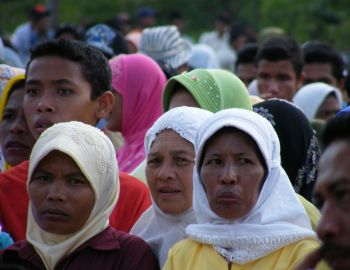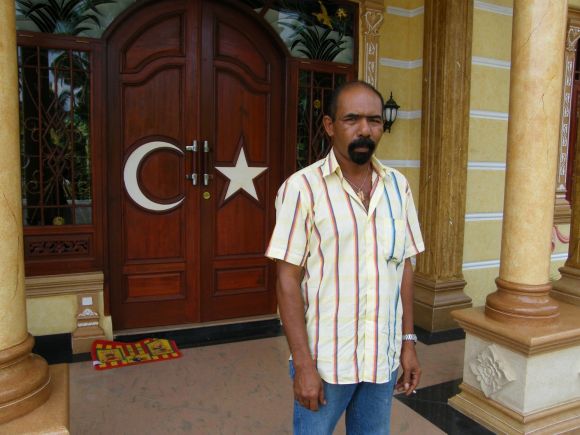How Indonesia’s democratic transition transformed Aceh
Edward Aspinall
In the first two or three years after the collapse of the Suharto regime in 1998, some people inside and outside the country thought Indonesia was on the verge of breaking up. Violent communal conflicts erupted in several parts of the country, notably in Kalimantan, Central Sulawesi and Maluku. Separatist movements re-emerged with new vigour in the three outlying provinces of Irian Jaya, Aceh and East Timor, and new separatist sentiment was stirring elsewhere. One common view was that this happened because the country was not yet ready for democratisation. Indonesia was said to be like a pressure cooker – take off the lid of authoritarian control and the country would explode.
Aceh seemed to present the clearest evidence for this gloomy assessment of the relationship between democracy, national unity and social peace. From early 1999, many Acehnese believed the momentum toward independence was unstoppable. One of the largest mass mobilisations in Indonesian history took place in November 1999. Hundreds of thousands gathered outside Banda Aceh’s Baiturrahman Mosque to demand an independence referendum. Armed rebellion was also better organised in Aceh than elsewhere. At its peak the Free Aceh Movement (Gerakan Aceh Merdeka, or GAM) controlled 70 percent of the countryside.
At the centre, the Aceh conflict seemed to turn democrats back into authoritarians. So important was Aceh to Indonesia’s national birth myth, and so visceral were the fears of national break-up, that successive post-Suharto presidents authorised stern military action against GAM. The mood of the parliament turned bellicose. The Unitary State of the Republic of Indonesia, condensed in the acronym NKRI (Negara Kesatuan Republik Indonesia), replaced the ‘Pancasila’ of the Suharto years as a catch-all phrase to justify human rights abuses of the worst kind. The depredations of the Suharto years repeated themselves in Aceh. The province became a giant military camp. Elsewhere the military had been forced into a humiliating political retreat. But in Aceh, after a time, officers spoke in public as if the old ‘dual function’ doctrine – giving the military both a security and a socio-political role – had never ended. They boasted that the armed forces were the last bastion of the Republic and the guardians of the state. They sneered at the capacity of civilian politicians to keep the country together. As most of Indonesia democratised, Aceh militarised.
Immediately after the December 2004 tsunami, I drove to Banda Aceh from Medan in a van with NGO activist friends from Jakarta. Not far past the border of Aceh, we passed a roadside military base. It was sunset, and the soldiers were ceremoniously pulling down the national flag for the night. They ordered all passing traffic – including the trucks carrying emergency relief – to stop in respect as they did so. ‘This doesn’t happen anywhere else these days’, my friends told me, shaking their heads and recalling the Suharto years. Going to Aceh was like passing into a time warp. I felt the Indonesian state was reproducing the very tactics that had caused the Acehnese to turn en masse against it in the first place. Even amidst the wreckage of the tsunami in Banda Aceh, people would approach me and whisper about their hatred of the security forces. One fisherman, trying to salvage machinery from his boat stranded in a suburban housing estate, looked around at the wreckage and told me: ‘They will never kill all the Acehnese, even if they try. For every GAM member they kill, ten take his place.’
Aceh’s transformation
 |
At a campaign rally for a former GAM member running as a district
|
Now, all this has changed. Since the August 2005 Helsinki peace accord, Aceh has become in some respects the most democratic part of Indonesia. Some of the restrictions on electoral participation elsewhere in the country do not operate there. Candidates for local government positions do not have to be nominated by political parties, but can stand as independents. In the provincial and district elections next year, members of local Aceh-based political parties will be able to run, whereas in every other province only national parties can do so. Democracy activists in other parts of the country now look to the Aceh model of independent candidates and local parties.
The post-Helsinki reforms have dramatically changed the government. In the local government elections in Aceh in December 2006, former guerrilla leaders and student activists ran for local government office, and many of them won. Irwandi Yusuf, the new governor, was a GAM propagandist and strategist, while his deputy Mohammad Nazar was a student leader in the 1999 referendum movement. Both are former political prisoners. Nowhere else have such implacable former dissidents won so much power.
The new democratic mood in post-Suharto Indonesia seeped into the mindset of the Acehnese independence fighters.
How did this come about? Many factors were important, but let me highlight three. First, it is unpalatable but true that military violence did play a part. After Suharto fell, GAM supporters did think independence had a chance, and they tried hard to get there. Indonesian military offensives, especially in 2003-04, were designed to prevent them. Without destroying GAM, they made it obvious that winning independence through armed struggle or even diplomacy was impossible. When they realised this, GAM leaders became more prepared to accept a compromise autonomy solution.
Second, Indonesia’s wider democratisation made Aceh’s transformation possible. In Suharto-era Aceh, there was no exit route from the spiral of military reprisals and armed revolt. Aceh was a ‘special territory’ in little more than name. Autonomy had little meaning while local people could not even choose their own leaders. This is why Suharto could not end the conflict. To return to the popular post-Suharto metaphor, democratisation made autonomy available as a way of slowly venting some steam from the pressure cooker without it exploding.
Third, more subtly, the new democratic mood in post-Suharto Indonesia seeped into the mindset of the Acehnese independence fighters. In the old days, GAM leaders depicted independence as the inalienable birthright of all Acehnese, inherited from their ancestors in the pre-colonial sultanate. But many members of the 1999-2000 student-led referendum movement had different views. That movement grew out of the wider anti-Suharto student activism of the late 1990s, where all spoke the language of democracy, rejecting militarism and campaigning for human rights and political freedoms. The Acehnese pro-referendum students said leaving Indonesia would be an escape from army abuses. They talked about independence not as a birthright, but as something to be determined through a democratic vote. Muhammad Nazar always said that if a majority voted to stay with Indonesia, he would respect that choice.
In short, democracy joined history as a justification for the Acehnese struggle. This change in mood affected the GAM leaders, who began to use similar language to that of the students. First, around 1999, GAM leaders said they would accept a referendum as a means to resolve the Aceh conflict, and would respect the results no matter what the outcome (previously, they had rejected a referendum because Aceh had ‘always’ been a sovereign state since time immemorial). Later, in the 2005 peace talks, they went further and said their real goal was to ensure Aceh became a true democracy and that its people had the right to determine their government and future. Surreptitiously, ‘democracy’ had replaced ‘independence’ as the main goal. This created space for compromise with Indonesian government leaders. The rest is history.
Contemporary challenges
Of course, it would be ludicrous to say Aceh has become some sort of democratic paradise. Nor are its people suddenly enjoying greatly improved living standards. Aceh is not immune from the problems afflicting democracy in other parts of Indonesia. In many ways the problems are more severe: Aceh is a traumatised society.
Like other post-conflict societies, Aceh confronts the problem of how to accommodate (or ‘reintegrate’ as the peace-building lexicon would put it) the former GAM combatants. During the war years, GAM fighters became experts at raising funds not only from voluntary contributions but also in the black economy and by extortion. Gangsterism is now rife in Aceh, and the perpetrators are often former GAM fighters. Many of the low-level violent incidents that plague Aceh today are related to competition for economic resources among former fighters. Higher up the food chain, some key former commanders are transforming themselves into a parasitical business elite, enriching themselves by gaining favoured access to government contracts and licences.
Democratisation has provided new ways of addressing old problems.
Conflict with the central government has also not disappeared; it has simply taken non-violent form. In 2006, the Indonesian parliament passed the Law for the Governing of Aceh (LoGA). GAM supporters thought this should provide for almost unfettered Acehnese ‘self-government’. Yet in reality Indonesia in some respects remains highly centralised. From control over hydrocarbon revenues to seemingly petty (but in fact crucial) areas like the right to hire and fire public servants, there are ongoing disputes between the governments in Aceh and Jakarta. Even when it came to registering a new local political party for former GAM members, the central government insisted it could not use the word Free (Merdeka) in its name.
Many other issues could trigger fresh conflict. In the centre, south and west of the province, some are campaigning for the formation of new provinces that would split from Aceh. They claim this will redress decades of neglect of these areas. Acehnese nationalists reject this stand – mostly without recognising the irony – saying that Aceh has always been an indivisible unity and should not be broken up. They also point to the fact that at least some of the leaders of these new province movements aligned with anti-GAM militias during the conflict years, and they mutter darkly about hidden plans to spark new violence
Decompression
Some gloomy commentators tell us that old Suharto-era elites have captured the institutions of democracy, and that old patterns of abuse of office are entrenched. At the local level, some say, autonomy has not empowered the people but has simply proliferated petty fiefdoms. Such views contain some truth, but they also miss the many changes that have taken place. Democratisation has provided new ways of addressing old problems. It has opened the political system to a wider range of participants. The changes have been most dramatic in Aceh because the challenges there were the greatest.
Aceh has become in some respects the most democratic part of Indonesia.
For all its continuing problems, Aceh is now far better off than during the Suharto era, when the military’s methods of dealing with local discontent steadily brought the province to boiling point. Around 30,000 people – perhaps many more – were killed during the resulting war. Poverty increased dramatically. The legacies of these bleak years will mark Acehnese society for many years to come. But at least the possibility is now open that Aceh’s problems can be resolved in a spirit of compromise. ii
Edward Aspinall (edward.aspinall@anu.edu.au) is a researcher at the Australian National University and the coordinating editor of Inside Indonesia. His book Islam and Nation: Separatist Conflict in Aceh, Indonesia is forthcoming with Stanford University Press.
